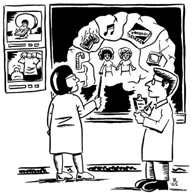The science of sisters and smell
The science of sisters and smell McGill University
User Tools (skip):
The science of sisters and smell

Jack Ruttan
Let's get the jokes out of the way. Axillary secretions of the B.O. sisterhood. Sisters are smelling themselves, for themselves. Sisterhood of the travelling unwashed T-shirts. The fact is, McGill is big on female body odour this spring, and it's got nothing to do with the locker rooms in the Sports Complex.
"When people hear we're studying body odour," admits Julie Boyle, research assistant at the Montreal Neurological Institute's Chemical Senses Laboratory, "they do tend to get really interested."
Boyle is working with neurology professor Marilyn Jones-Gotman on the first-ever brain-imaging study of female human identification of body odour. The work is an extension of Jones-Gotman's previous investigations into human pheromones, and was inspired by the work of research fellow Johan Lundstrom.
"Using brain imaging," says Jones-Gotman, "we're looking for evidence of differential treatment by the brain of body odours as compared to other odours."
The researchers are recruiting test subjects (females aged 18 to 30), who in turn enlist a sister and a close female friend. Once accepted into the study, all three women are required to sleep in tight white T-shirts, customized with special odour-absorbent pads sewn into the underarms, for seven days. The shirts cannot be washed for this period, and several other requirements (for example, showering with special scentless soap before bed, sleeping alone and certain dietary restrictions) must be fulfilled in order not to contaminate their body odours.
After the week is up, the three shirts are rushed to the lab, where the armpit-pads are removed, placed in jars and frozen (to preserve the bacteria). The research subject (but not her sister or friend) then undergoes a series of tests, using the pads, to determine how well she can identify each of the three different body odours. "Oddly enough," notes Boyle, "people are bad at identifying their own body odour!"
If the subject can successfully differentiate between kin and non-kin at least 90 percent of the time, she moves on to the PET (positron emission tomography) scan stage of the project. PET scans use low-level radiation (roughly the equivalent of the ultraviolet radiation one would receive from living in New York City for 100 days) to create a physiologic image of brain activity while the subject is performing a certain task.
In this case, the task is sniffing B.O. During the 60-second scan, one of the open jars is placed over the subject's nose: The odour may be one of the three samples collected using the T-shirts, the body odour collected from a stranger or a chemical mixture resembling the hedonic value of body odour.
"We use the chemical odour to compare how brain activity while smelling body odours compares to that while smelling non-body odours," says Jones-Gotman. "There's also a scan with a clean air baseline: we tell the subjects they're not going to be smelling anything during the baseline scan, but ask them to sniff as if they're smelling an odour."
The process involves 12 scans, each separated by 10-minute breaks to allow the cyclotron to produce the next scan's radioactive tracers. The scans are conducted in one session, lasting approximately two and a half hours.
"The PET scans provide the functional data," says Boyle. "Then we need anatomical data, so the subject returns for an MRI scan." Magnetic Resonance Imaging uses magnetic and radio waves to create a very detailed picture of the brain; the scan takes approximately 20 minutes to complete. After the MRI scan, the subject's work is done. She receives $130 for her participation; her sister and friend each receive $30.
The study marks a brave new phase in the world of body odour. Jones-Gotman is excited by what they may learn, but says they don't have a particular hypothesis regarding women specifically, let alone sisters, and the identification of B.O. "Odour identification is a very complicated question," she says, "so we're trying to simplify it just a bit.
"The reason we chose women as our subjects was because we wanted to maximize our chances of getting strong results," she adds. "In identification task studies using large numbers of subjects, women are shown to be better than men at identifying odours. Women's odour-identifying abilities also don't decrease as much with age."
Seven women (and their sisters and friends) have already completed the study, but the researchers are resisting the temptation to dive into the data. "By the time we have eight subjects," admits Jones-Gotman, "we probably won't be able to hold our curiosity any longer and we'll start doing analyses."
Women who are interested in participating in the study should call 398-4400, ext. 089712, or send an email.
